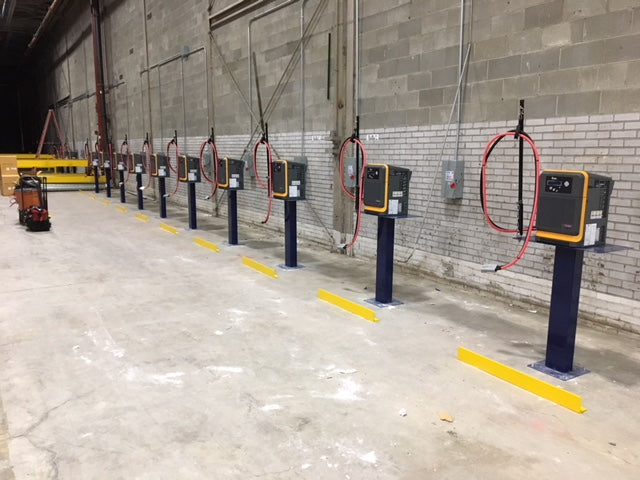
Setting Up an Efficient Battery Charging Area in a Warehouse for Forklift Batteries
Introduction:
Efficient battery charging becomes crucial in a bustling warehouse environment, where forklifts and other electric vehicles are essential for day-to-day operations. A well-designed battery charging area helps optimize workflow and charging procedures while eliminating downtime due to broken equipment. It is common to walk into a warehouse and see charging cables on the floor, broken connectors due to trucks running over them, or trucks sitting in aisles not plugged-in during breaks. We recently had the opportunity to sit down and speak to industry expert Robin Hartman with Weldex to discuss how she approaches designing a great charging area and ensures batteries are constantly being plugged in at breaks. Robin walked us through the essential areas she focuses on when determining how a charging area could be improved or designed.
Safety First! Making sure employees and equipment are protected.
Safety should always be the top priority when establishing a battery charging area. Proper safety measures minimize the risk of accidents and ensure a secure working environment. However, did you know it is not only a good idea to keep charging areas up to proper safety standards but is also an OSHA regulation, per standard 1926.444? (Department of Labor Logo United States Department of Labor. 1926.441 - Batteries and battery charging.)
Many regulations fall under this OSHA standard. Some requirements, such as eyewash stations and proper ventilation, may seem like a given. But did you know there are also requirements specific to protecting charging equipment? We compiled a complete list of regulations that fall under this standard below.
Charging Equipment Protection Standards
- There should be dedicated battery charging areas.
- Chargers and charger accessories must be protected from damage by trucks. Pogo sticks, charger stands, and wall mounts are great ways to help protect your equipment.
- Vent caps must be kept in the cell when batteries are charging to avoid electrolyte spray. All vent caps must remain in functioning condition. Keeping replacement vent caps or watering system parts on hand. We work in a busy environment that can be hard on equipment. It is not uncommon for things such as caps, valves, or couplers to become damaged during day-to-day activities.
Employee and Facility Safety Standards
- Unsealed batteries must be in areas with outside vents or well-ventilated rooms. They should be arranged to prevent the escape of fumes, gases, or electrolyte spray into other areas of the warehouse.
- Proper ventilation must be provided to ensure the diffusion of gases from the battery and prevent explosive mixtures from accumulating.
- Racks and trays must be resistant to electrolytes. There are a variety of different options to help with acid containment. Whether you opt for floor mats or a complete acid containment system, we are here to help!
- Floors should be acid resistant or have acid accumulations.
- Face shields, aprons, and rubber gloves should be provided for workers handling batteries.
- Eye wash stations and emergency showers must be within 25 feet of the battery handling areas.
- Facilities should be prepared to flush and neutralize acid spills and for fire protection.
- There should be dedicated battery charging areas.
- Chargers and charger accessories must be protected from damage by trucks.
- Vent caps must be kept in the cell when batteries are charging to avoid electrolyte spray. All vent caps must remain in functioning condition.
Expert Suggestions for Designing an OSHA-Compliant Charging Area
One of the most critical factors in ensuring efficient charging practices included a streamlined design and layout of the battery charging area, which can significantly enhance productivity and minimize downtime. Here are some key considerations Robin always addresses when designing or improving a charging area;
- Space Allocation: Allocate sufficient space for the charging area, taking into consideration your fleet's number of forklifts and batteries. Ensure there is ample room for maneuvering and safe battery handling.
- Charging Stations: Install dedicated charging stations equipped with appropriate chargers for the specific type of batteries used in your forklifts. Label each station clearly for easy identification.
- Charging Racks or Cabinets: Utilize charging racks or cabinets to organize and store batteries during charging. These racks should be sturdy, fire-resistant, and designed to prevent accidental battery damage.
- Cable Management: Implement a well-organized cable management system to prevent tripping hazards and ensure easy access to charging ports.
We put together a list of our favorite accessories to take your battery charging area to the next level: (Click on the links below to view product options)
Eye Wash Stations and Emergency Showers
Conclusion:
Establishing a well-designed battery charging area in a warehouse for forklift batteries is essential for maintaining a smooth workflow and maximizing productivity. By prioritizing safety, incorporating efficient design and layout, implementing battery maintenance practices, and maintaining accurate records, you can ensure a reliable supply of charged batteries and prolong their lifespan. A carefully planned battery charging area will create a safer and more efficient warehouse operation.
Resources
Department of Labor Logo United Statesdepartment of Labor. 1926.441 - Batteries and battery charging. | Occupational Safety and Health Administration. (n.d.). https://www.osha.gov/laws-regs/regulations/standardnumber/1926/1926.441

Leave a comment